Air-Spaced Doublets, 532 nm and 1064 nm

- High Damage Threshold of 10 J/cm2
- Ø18 mm Clear Aperture
- Diffraction-Limited Spot Size
ACA254-075-1064
ACA254-050-532
Each mount includes an engraved arrow
indicating the direction of light propagation
required to collimate a point source.

Please Wait
| General Specifications | |
|---|---|
| Damage Threshold (-532 Lenses) |
10 J/cm2 (532 nm, Ø0.455 mm, 10 ns, 10 Hz) |
| Damage Threshold (-1064 Lenses) |
10 J/cm2 (1064 nm, Ø0.455 mm, 10 ns, 10 Hz) |
| Surface Quality | 10-5 Scratch-Dig (to Prevent Scattering from High Power Sources) |
| Transmitted Wavefront Error | ≤0.07λ(RMS)a |
| Focal Length Tolerance | ±1% |
| Clear Aperture | Ø18 mm |
| Reflectivity | R < 0.25% at 532 nm (-532 Lenses) or R < 0.25% at 1064 nm (-1064 Lenses) |
| Housing | Ø1" 6061-T6 Aluminum Barrel |
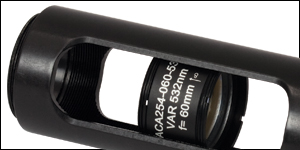
Click to Enlarge
Air-Spaced Doublet Mounted in SM1L30C Ø1" Slotted Lens Tube with Two SM1RR Retaining Rings
Features
- VAR-Coated for <0.25% Reflectivity at 532 nm or 1064 nm
- Air-Spaced Design Provides 10 J/cm2 Damage Threshold
- Ø18 mm Clear Aperture
- 1" Outer Diameter for Mounting Inside a Ø1" Lens Tube
Thorlabs' high-power air-spaced doublets are optimized to provide diffraction-limited performance at either 532 nm or 1064 nm. They feature an antireflection coating at the design wavelength (either 532 nm or 1064 nm) that provides excellent transmission when using Nd:YAG lasers. Air-spaced doublets have two more degrees of freedom than cemented doublets because the interior lens surfaces do not need to have the same curvature. These extra variables allow the performance of these air-spaced doublets to exceed the performance of equivalent cemented doublets in some cases. The air-spaced design is also highly resistant to laser damage, since no cement is utilized in the fabrication process. Please note that these doublets are not achromatic; they are designed to provide other advantages of doublets, such as diffraction-limited spot size, to users of high-power lasers.
The doublets are pre-mounted in an aluminum barrel with tight tolerances on lens and barrel diameter to minimize the effects of lens decentering. Each mount includes an engraving with the part number, AR coating wavelength, focal length, and the direction of light propagation required to collimate a point source. The mount has a 1" outer diameter for mounting inside a Ø1" lens tube (as shown in the photo to the lower right).
Note: We do not recommend disassembly of these lenses, as this may affect performance.
| Air-Spaced Doublets Selection Guide | |
|---|---|
| UV (245 - 400 nm) | D (1.65 - 3 µm) |
| Visible (350 - 700 nm) | E (3 - 5 µm) |
| NIR (650 - 1050 nm) | E3 (7 - 12 µm) |
| Laser-Line (532 & 1064 nm) | |
| Click on the red Document icon next to the item numbers below to access the Zemax file download. Our entire Zemax Catalog is also available. |
| Damage Threshold Specifications | |
|---|---|
| Coating Designation (Item # Suffix) |
Damage Threshold |
| -532 | 10 J/cm2 (532 nm, Ø0.455 mm, 10 ns, 10 Hz) |
| -1064 | 10 J/cm2 (1064 nm, Ø0.455 mm, 10 ns, 10 Hz) |
Damage Threshold Data for Thorlabs' Air-Spaced Doublets
The specifications to the right are measured data for Thorlabs' air-spaced doublets. Damage threshold specifications are constant for a given coating type, regardless of the focal length of the lens.
Laser Induced Damage Threshold Tutorial
The following is a general overview of how laser induced damage thresholds are measured and how the values may be utilized in determining the appropriateness of an optic for a given application. When choosing optics, it is important to understand the Laser Induced Damage Threshold (LIDT) of the optics being used. The LIDT for an optic greatly depends on the type of laser you are using. Continuous wave (CW) lasers typically cause damage from thermal effects (absorption either in the coating or in the substrate). Pulsed lasers, on the other hand, often strip electrons from the lattice structure of an optic before causing thermal damage. Note that the guideline presented here assumes room temperature operation and optics in new condition (i.e., within scratch-dig spec, surface free of contamination, etc.). Because dust or other particles on the surface of an optic can cause damage at lower thresholds, we recommend keeping surfaces clean and free of debris. For more information on cleaning optics, please see our Optics Cleaning tutorial.
Testing Method
Thorlabs' LIDT testing is done in compliance with ISO/DIS 11254 and ISO 21254 specifications.
First, a low-power/energy beam is directed to the optic under test. The optic is exposed in 10 locations to this laser beam for 30 seconds (CW) or for a number of pulses (pulse repetition frequency specified). After exposure, the optic is examined by a microscope (~100X magnification) for any visible damage. The number of locations that are damaged at a particular power/energy level is recorded. Next, the power/energy is either increased or decreased and the optic is exposed at 10 new locations. This process is repeated until damage is observed. The damage threshold is then assigned to be the highest power/energy that the optic can withstand without causing damage. A histogram such as that below represents the testing of one BB1-E02 mirror.

The photograph above is a protected aluminum-coated mirror after LIDT testing. In this particular test, it handled 0.43 J/cm2 (1064 nm, 10 ns pulse, 10 Hz, Ø1.000 mm) before damage.

| Example Test Data | |||
|---|---|---|---|
| Fluence | # of Tested Locations | Locations with Damage | Locations Without Damage |
| 1.50 J/cm2 | 10 | 0 | 10 |
| 1.75 J/cm2 | 10 | 0 | 10 |
| 2.00 J/cm2 | 10 | 0 | 10 |
| 2.25 J/cm2 | 10 | 1 | 9 |
| 3.00 J/cm2 | 10 | 1 | 9 |
| 5.00 J/cm2 | 10 | 9 | 1 |
According to the test, the damage threshold of the mirror was 2.00 J/cm2 (532 nm, 10 ns pulse, 10 Hz, Ø0.803 mm). Please keep in mind that these tests are performed on clean optics, as dirt and contamination can significantly lower the damage threshold of a component. While the test results are only representative of one coating run, Thorlabs specifies damage threshold values that account for coating variances.
Continuous Wave and Long-Pulse Lasers
When an optic is damaged by a continuous wave (CW) laser, it is usually due to the melting of the surface as a result of absorbing the laser's energy or damage to the optical coating (antireflection) [1]. Pulsed lasers with pulse lengths longer than 1 µs can be treated as CW lasers for LIDT discussions.
When pulse lengths are between 1 ns and 1 µs, laser-induced damage can occur either because of absorption or a dielectric breakdown (therefore, a user must check both CW and pulsed LIDT). Absorption is either due to an intrinsic property of the optic or due to surface irregularities; thus LIDT values are only valid for optics meeting or exceeding the surface quality specifications given by a manufacturer. While many optics can handle high power CW lasers, cemented (e.g., achromatic doublets) or highly absorptive (e.g., ND filters) optics tend to have lower CW damage thresholds. These lower thresholds are due to absorption or scattering in the cement or metal coating.

LIDT in linear power density vs. pulse length and spot size. For long pulses to CW, linear power density becomes a constant with spot size. This graph was obtained from [1].

Pulsed lasers with high pulse repetition frequencies (PRF) may behave similarly to CW beams. Unfortunately, this is highly dependent on factors such as absorption and thermal diffusivity, so there is no reliable method for determining when a high PRF laser will damage an optic due to thermal effects. For beams with a high PRF both the average and peak powers must be compared to the equivalent CW power. Additionally, for highly transparent materials, there is little to no drop in the LIDT with increasing PRF.
In order to use the specified CW damage threshold of an optic, it is necessary to know the following:
- Wavelength of your laser
- Beam diameter of your beam (1/e2)
- Approximate intensity profile of your beam (e.g., Gaussian)
- Linear power density of your beam (total power divided by 1/e2 beam diameter)
Thorlabs expresses LIDT for CW lasers as a linear power density measured in W/cm. In this regime, the LIDT given as a linear power density can be applied to any beam diameter; one does not need to compute an adjusted LIDT to adjust for changes in spot size, as demonstrated by the graph to the right. Average linear power density can be calculated using the equation below.

The calculation above assumes a uniform beam intensity profile. You must now consider hotspots in the beam or other non-uniform intensity profiles and roughly calculate a maximum power density. For reference, a Gaussian beam typically has a maximum power density that is twice that of the uniform beam (see lower right).
Now compare the maximum power density to that which is specified as the LIDT for the optic. If the optic was tested at a wavelength other than your operating wavelength, the damage threshold must be scaled appropriately. A good rule of thumb is that the damage threshold has a linear relationship with wavelength such that as you move to shorter wavelengths, the damage threshold decreases (i.e., a LIDT of 10 W/cm at 1310 nm scales to 5 W/cm at 655 nm):

While this rule of thumb provides a general trend, it is not a quantitative analysis of LIDT vs wavelength. In CW applications, for instance, damage scales more strongly with absorption in the coating and substrate, which does not necessarily scale well with wavelength. While the above procedure provides a good rule of thumb for LIDT values, please contact Tech Support if your wavelength is different from the specified LIDT wavelength. If your power density is less than the adjusted LIDT of the optic, then the optic should work for your application.
Please note that we have a buffer built in between the specified damage thresholds online and the tests which we have done, which accommodates variation between batches. Upon request, we can provide individual test information and a testing certificate. The damage analysis will be carried out on a similar optic (customer's optic will not be damaged). Testing may result in additional costs or lead times. Contact Tech Support for more information.
Pulsed Lasers
As previously stated, pulsed lasers typically induce a different type of damage to the optic than CW lasers. Pulsed lasers often do not heat the optic enough to damage it; instead, pulsed lasers produce strong electric fields capable of inducing dielectric breakdown in the material. Unfortunately, it can be very difficult to compare the LIDT specification of an optic to your laser. There are multiple regimes in which a pulsed laser can damage an optic and this is based on the laser's pulse length. The highlighted columns in the table below outline the relevant pulse lengths for our specified LIDT values.
Pulses shorter than 10-9 s cannot be compared to our specified LIDT values with much reliability. In this ultra-short-pulse regime various mechanics, such as multiphoton-avalanche ionization, take over as the predominate damage mechanism [2]. In contrast, pulses between 10-7 s and 10-4 s may cause damage to an optic either because of dielectric breakdown or thermal effects. This means that both CW and pulsed damage thresholds must be compared to the laser beam to determine whether the optic is suitable for your application.
| Pulse Duration | t < 10-9 s | 10-9 < t < 10-7 s | 10-7 < t < 10-4 s | t > 10-4 s |
|---|---|---|---|---|
| Damage Mechanism | Avalanche Ionization | Dielectric Breakdown | Dielectric Breakdown or Thermal | Thermal |
| Relevant Damage Specification | No Comparison (See Above) | Pulsed | Pulsed and CW | CW |
When comparing an LIDT specified for a pulsed laser to your laser, it is essential to know the following:

LIDT in energy density vs. pulse length and spot size. For short pulses, energy density becomes a constant with spot size. This graph was obtained from [1].
- Wavelength of your laser
- Energy density of your beam (total energy divided by 1/e2 area)
- Pulse length of your laser
- Pulse repetition frequency (prf) of your laser
- Beam diameter of your laser (1/e2 )
- Approximate intensity profile of your beam (e.g., Gaussian)
The energy density of your beam should be calculated in terms of J/cm2. The graph to the right shows why expressing the LIDT as an energy density provides the best metric for short pulse sources. In this regime, the LIDT given as an energy density can be applied to any beam diameter; one does not need to compute an adjusted LIDT to adjust for changes in spot size. This calculation assumes a uniform beam intensity profile. You must now adjust this energy density to account for hotspots or other nonuniform intensity profiles and roughly calculate a maximum energy density. For reference a Gaussian beam typically has a maximum energy density that is twice that of the 1/e2 beam.
Now compare the maximum energy density to that which is specified as the LIDT for the optic. If the optic was tested at a wavelength other than your operating wavelength, the damage threshold must be scaled appropriately [3]. A good rule of thumb is that the damage threshold has an inverse square root relationship with wavelength such that as you move to shorter wavelengths, the damage threshold decreases (i.e., a LIDT of 1 J/cm2 at 1064 nm scales to 0.7 J/cm2 at 532 nm):

You now have a wavelength-adjusted energy density, which you will use in the following step.
Beam diameter is also important to know when comparing damage thresholds. While the LIDT, when expressed in units of J/cm², scales independently of spot size; large beam sizes are more likely to illuminate a larger number of defects which can lead to greater variances in the LIDT [4]. For data presented here, a <1 mm beam size was used to measure the LIDT. For beams sizes greater than 5 mm, the LIDT (J/cm2) will not scale independently of beam diameter due to the larger size beam exposing more defects.
The pulse length must now be compensated for. The longer the pulse duration, the more energy the optic can handle. For pulse widths between 1 - 100 ns, an approximation is as follows:

Use this formula to calculate the Adjusted LIDT for an optic based on your pulse length. If your maximum energy density is less than this adjusted LIDT maximum energy density, then the optic should be suitable for your application. Keep in mind that this calculation is only used for pulses between 10-9 s and 10-7 s. For pulses between 10-7 s and 10-4 s, the CW LIDT must also be checked before deeming the optic appropriate for your application.
Please note that we have a buffer built in between the specified damage thresholds online and the tests which we have done, which accommodates variation between batches. Upon request, we can provide individual test information and a testing certificate. Contact Tech Support for more information.
[1] R. M. Wood, Optics and Laser Tech. 29, 517 (1998).
[2] Roger M. Wood, Laser-Induced Damage of Optical Materials (Institute of Physics Publishing, Philadelphia, PA, 2003).
[3] C. W. Carr et al., Phys. Rev. Lett. 91, 127402 (2003).
[4] N. Bloembergen, Appl. Opt. 12, 661 (1973).
| Posted Comments: | |
Tony Hainsworth
(posted 2023-10-11 09:08:53.877) I am looking for lenses to give a diffraction limited spot with a 1064nm laser. Even though they are laser line coated will these air spaced doublets made from N-BK7 be suitable for high power use? I have a 5kW ~10mm diameter beam. My go to choice would be for fused silica substrates, I want to have minimum thermal focus shift and suspect that the N-BK7 performance would be much poorer compared to FS. jdelia
(posted 2023-10-13 02:10:05.0) Thank you for contacting Thorlabs. I have contacted you directly to discuss the parameters of your beam in an effort to validate whether it would be suitable for this optic. You are correct, UVFS will have superior performance to N-BK7 regarding thermal focus shift. wupinghan
(posted 2017-10-03 10:33:34.707) Dear sir:
Do you have a Air-Spaced Doublets, 1064 nm for focal length 20 mm or 25 mm. Thank you! nbayconich
(posted 2017-10-04 05:17:43.0) Thank you for contacting Thorlabs. I will reach out to you directly about our custom capabilities. genevieve.moreas
(posted 2013-08-12 09:24:25.203) Good afternoon
whre can I find the Zemax file of the ACA254-060-532 ?
Thank you in advance for your answer
Best regards
Genevieve Moreas, Ir sharrell
(posted 2013-08-12 11:50:00.0) Response from Sean at Thorlabs: Thank you for contacting us. Zemax files (both .zar and .zmx) files for these lenses (and most other optics) can be found by clicking the red "Docs" icon next to the item number in the ordering table. I will send you the files directly as well. stevedejarnette
(posted 2013-05-17 16:55:03.81) I'm looking for a lens for a telescope I'm building. But not sure If your product would be applicable. Thanks,Steve jlow
(posted 2013-05-20 14:05:00.0) Response from Jeremy at Thorlabs: We will get in contact with you directly to discuss about your application. bdada
(posted 2011-12-28 12:10:00.0) Response from Buki at Thorlabs:
Thank you for your feedback. The air spaced doublets are not achromatic. We have sent you some data that shows the focal length shift with wavelength and will add this data to our website shortly.
We will soon release some air spaced achromatic doublets. Please contact TechSupport@thorlabs.com if you have any questions. bmangum
(posted 2011-12-15 15:37:10.0) Do these work as achromats?
Is there any plot available showing focal length shift as a function of wavelength for these lenses? |
Thorlabs offers a wide selection of optics optimized for use with Nd:YAG lasers. Please see below for more information.

*Center air spacing between the lenses.
| Item # | AR Coating Plot | Focal Length Shift Plot* | Convex Lens Material |
Meniscus Lens Material |
|---|---|---|---|---|
| ACA254-030-532 | Raw Data |
N-SF11 | N-SF11 | |
| ACA254-050-532 | N-SF11 | N-BK7 | ||
| ACA254-060-532 | N-SF11 | N-BK7 | ||
| ACA254-075-532 | N-BK7 | N-BK7 | ||
| ACA254-100-532 | N-BK7 | N-BK7 | ||
| ACA254-150-532 | N-BK7 | N-BK7 | ||
| ACA254-200-532 | N-BK7 | N-BK7 |
*Click Here to download focal length shift data.

*Center air spacing between the lenses.
| Item # | AR Coating Plot | Focal Length Shift Plot* | Convex Lens Material |
Meniscus Lens Material |
|---|---|---|---|---|
| ACA254-030-1064 | Raw Data |
N-SF11 | N-SF11 | |
| ACA254-050-1064 | N-SF11 | N-SF11 | ||
| ACA254-060-1064 | N-SF11 | N-BK7 | ||
| ACA254-075-1064 | N-BK7 | N-BK7 | ||
| ACA254-100-1064 | N-BK7 | N-BK7 | ||
| ACA254-150-1064 | N-BK7 | N-BK7 | ||
| ACA254-200-1064 | N-BK7 | N-BK7 |
*Click Here to download focal length shift data.
 Products Home
Products Home
















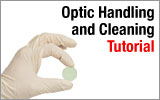



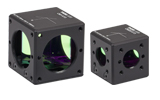
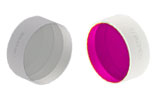

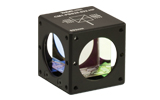



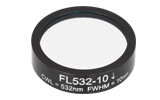
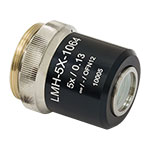
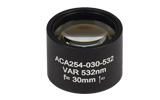

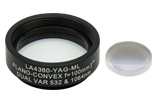

 Laser Line Air-Spaced Doublets
Laser Line Air-Spaced Doublets